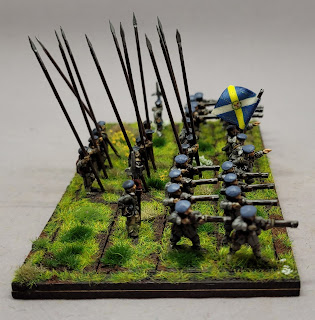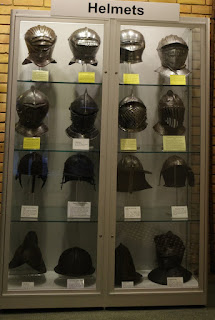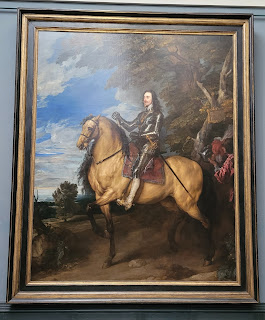Coat Colours Part 1: Parliamentarian Regiments of Foot
|
When I
first started my Civil War gaming project I relied upon the many ECW coat
colour tables on wargaming websites. As my project has progressed, my library
has got bigger, my research has gone back to primary sources rather than
relying upon second and third hand sources; and I have noticed quite a few
errors in these lists for wargamers. I have also noticed the same errors
appearing in multiple lists.
As a result of continually seeing 'the London Trained Bands and their Auxiliaries wore red coats' (there is no evidence supporting this at all, the evidence, whilst not explicit suggests that the London Trained Bands wore civilian clothes - some of the Auxiliaries might have been issued with blue winter coats) I decided to write my own list. So here
it is. If your allegiance lies elsewhere you might want to look at Part 3B Montrose and the Irish Brigade Part 4 Dragoons, Horse and the New Model Army coat colours The Trained Bands The golden rule of ECW coat colours: there was no uniformity with uniforms. If a regiment had been issued red coats, don't expect them to have identical matching red coats, instead we'd probably see a mix of shades of red, and some soldiers with completely different coloured coats. Dyes were less consistent, and often not colourfast. Coats were issued and reissued, colours changed. Also remember that the references that we have cover small windows of time. Regiments often got renamed when command passed to a new colonel - these regiments are listed under their first name e.g. Aldrich's Regiment was originally Lord Saye and Sele's Regiment. Coat colour notes refer to contemporaneous references and some of the deductions made by Peachey and Prince. You will also notice that some regiments have several coat colours listed. Where there is some question around a coat colour I have tried to give an explanation or provide notes.
There are a large number of
regiments not included in this list - we don't know if they had coats issued,
or in those cases where they were issued we don't have any colour recorded. |
|
|
Col
Thomas Ayloffe |
Spring
has deduced they were likely red-coated in April/May 1645 (Laurence Spring The Regiments of
the Eastern Association ref. BL Add MS 18982 f409 ) |
|
|
|
|
Col
Thomas Ballard later Col Francis Martin |
grey
coats lined white (Thomason
Tracts E124(33); National Archive SP28/2/90, 28/298/468) from Sept 1642 receiving a new
issue in Aug 1643 that was probably red or grey (You'll
notice a lot of regiments being issued new coats in Aug 1643 - these
regiments relieved the siege of Gloucester, there are records of thousands of
red and grey coats being issued, but no details of who got what sadly) (Bodleian Library Tanner MS 62) |
|
|
|
|
Col
Harry Barclay |
Red
coats lined blue (National Archive SP28/3A/116) in Nov 1642, these were
replaced, probably with red or grey in Aug 1643 (Bodleian Library Tanner MS 62) |
|
|
|
|
Col
William Beale later Col John Carter |
None
issued soldiers were issued ribbons and scarves for the officers (National
Archive SP28/144/part 10/f186) |
|
|
|
|
Col
John Birch later Col J Humphries |
Red (National Archive SP128, 130) |
|
|
|
|
Col
John Bright later Lambert’s, Fleetwood’s, Eyre’s then Birches’s |
1645
(As Bright’s) green coats lined yellow (The Three Sieges of Pontefract
Castle, The First Siege, page 45 George Fox) |
|
|
|
|
Lord
Brooke’s (Edgehill) |
Purple
lined white. (Thomason Tracts E124(33)) Please note his
midland regiment most likely did not wear purple, it isn’t certain that they
were issued with coats at all |
|
|
|
|
Sir
William Brereton's |
Grey (National Archive
SP28/134/12 F395r) April 1645 Staffordshire Committee paid for grey coats
for Captain Monke's company |
|
|
|
|
Major
General Richard Browne |
Possibly red (National Archive SP28/144/pt2/28-35) coats from 1642, by 1645 they
were wearing grey (BL Add 18,982 F409) |
|
|
|
|
Col
Henry Bulstrode later Col Cunningham’s, later Col Richard Fortescue |
1642
unknown coat colour issued, 1643 red or grey coats
issued (Bodleian
Library Tanner MS 62) |
|
|
|
|
Colonel
James Carr |
In Dec
1644 several 'poor soldiers' of Carr's regiment, and probably other Plymouth
garrison units, received waistcoats made from old wall-hanging's confiscated
from Lord Astley's house in Plymouth. (National Archive SP28.128.17) |
|
|
|
|
Sir
Henry Chomley |
1642 blue
coats lined white (Letters of Nehemiah Warton) |
|
|
|
|
Sir
William Constable’s Southern Regt |
Blue (Thomason Tracts E124(33)) coats in Sept 1642, they were
next issued coats in Aug 1643, which were probably red or grey (Bodleian Library Tanner MS 62) |
|
|
|
|
Sgt Maj
Gen Lawrence Crawford |
Blue (Thomason Tracts E54/20,
E54/7) -
probably the regiment at Marston Moor referred to as “Manchester’s blewcoats”
– equally might refer to Hobart’s - although Hobart’s were referred to as
‘Norfolk red coats’ some four months earlier at Newark. |
|
|
|
|
Col
Charles Essex |
1642 tawny
coats lined yellow (National Archive SP28/2/89) |
|
|
|
|
Earl of
Essex |
Orange
tawney (Thomason Tracts
E124(33)) coats
from Sept 1642 until re-clothed in an unknown colour Aug 1643 |
|
|
|
|
Earl of
Essex’s Guard of Halberdiers |
Grey cassocks festooned with
over 180 silver and orange buttons (National Archive SP28/2B) |
|
|
|
|
Sir
William Fairfax |
Probably grey coats
- presumed to be the 'grey coats' mentioned in an Oxford street fight (National Archive SP28/1/164) |
|
|
|
|
Sir
John Gell |
Grey (National Archive SP28/226/pt2, SP28/226/pt3) |
|
|
|
|
Col
Thomas Grantham |
1642 Tawny
lined white (National Archive SP28/2/88) |
|
|
|
|
Lord
Grey of Groby |
Possibly blue –
raised at same time and place as Lord Grey’s father’s regt (Earl of Stamford)
who wore blue coats, believed both regts equipped the same. No definitive
specific reference though. |
|
|
|
|
Col
John Hampden later Col Thomas Tyrell’s |
Green
lined yellow (Thomason Tracts E127(120);
National Archive SP28/239) under Hampden, 1643 reissue possibly kept the
green coat colour “Colonell Thomas Terill Colonell of ye green Regimt late of
Colonell Hampden” – although could be reference to flags |
|
|
|
|
Sir
Arthur Hesilrige |
Blue (Thomason Tracts E50(5),
E50(9)) |
|
|
|
|
Sir
Miles Hobart |
Red, described as the “Norfolk
redcoats” at Newark in 1644 (BL
Tanner MS62, National Archive SP28/26) |
|
|
|
|
Col
James Holborne later Col William Davies’s |
Issued
coats Nov 1642, colour not noted. Aug 1643 issued new coats in red or
grey (Bodleian
Library Tanner MS 62) |
|
|
|
|
Col
Denzil Holles |
1642 red coats lined white issued (Thomason Tracts E124(33), E127(12), E127(21), E127(260, E128(28)) |
|
|
|
|
Col
John Holmstead |
Issued red
coats lined white (National Archive SP28/3/504, 28/4/316) Nov 1642, Aug 1643 issued
new coats in red or grey (Bodleian Library Tanner MS 62) |
|
|
|
|
Col
Samuel Jones later Col John Fielder |
Green - the “Farnham greencoats" (Thomason Tracts E101(64); National Archive SP28/244) |
|
|
|
|
Col
George Langham |
Issued blue
coats lined white (Thomason Tracts E129(6), E129(25)) Nov 1642, Aug 1643 issued
new coats in red or grey (Bodleian Library Tanner MS 62) |
|
|
|
|
Col
John Leigh |
Most
likely grey, the constables of Mere sent money for grey coats for
the Knutsford garrison, who were most likely Leigh's regiment (British Library Harley
MS 2128 F60r) |
|
|
|
|
Sgt
Major General Randall Mainwaring |
Wore red
coats lined white in Mar 1643 and noted with red coats in Jan 1644.(National Archive SP28 261 part
3 f. 296) Mainwaring
was the major of the Red LTB Regiment when he recruited his own Regiment of
redcoats. Symons conflated the two into one (he was relying on second
hand information as he didn't witness the event he recorded) and so the myth
of the LTB wearing red coats was born. A first hand account of the Gloucester
expedition clearly identifies Mainwaring's red coats and the Red LTB
regiment as separate entities. |
|
|
|
|
Earl of
Manchester |
Complicated! There are references
ordering green coats lined in red and red coats
lined in green (National
Archive SP28/26) and red coats lined in blue (National Archive SP28/26) Is there an error? Did they wear different
colours at different times? Was part of the regiment red-coated and part
green-coated? Spring proposes that, since it was a double-sized regiment, one
'battalion' wore green coats and the other red coats. Another hypothesis is
that Major Homes was drawing the coats for the army rather than his company
in Manchester's Regiment). For interest: the Sealed Knot re-enactment group
have plumped for red coats some lined blue, some green. |
|
|
|
|
Lord
Mandeville |
1642 blue (National Archive SP28/2/134) |
|
|
|
|
Sir
John Merrick |
Grey
coats lined white (Thomason Tracts E100(16), E100(20, E103(12)) |
|
|
|
|
Col
Edward Montagu (not Earl of Manchester!) |
Red
coats lined white (National Archive SP24) |
|
|
|
|
Col
Herbert Morley |
1642 red (National Archive SP28/262/374), 1645 grey (Thomason Tracts E293(23)) |
|
|
|
|
Sir
Thomas Myddleton |
Red(?) In 1644 Myddleton paid for
36 red coats (National Archive SP28/346/unfoliated) |
|
|
|
|
Sir
John Palgrave |
Possibly Red (National Archive SP 28/26) |
|
|
|
|
Col
George Payne |
Blue (British Library Add 18,982
F409) |
|
|
|
|
Earl of
Peterborough |
Red
lined blue when
reformed Nov 1642 (National Archive SP28/3B(1)) |
|
|
|
|
Col
John Pickering |
Red
lined blue 1644 (National Archive SP28/26, SP28/128) |
|
|
|
|
Major General Christopher
Potley later Col David Leighton’s/Leyton's, then Sir Hardress Waller’s |
Possibly yellow,
then grey - a reference to Waller’s Army in yellow
coats (National Archive SP28/134/part 7) could be Potley’s or
could refer to Waller’s Regt. 1645 Greycoats of 'Col Leyton's' put into
Hardress Waller's regiment (Thomason Tracts E293(23)) |
|
|
|
|
Col
Thomas Rainsborough later Col Grey |
Red (British Library Add 18,982
F409) |
|
|
|
|
Col
Alexander Rigby |
Grey a council of war, Preston 12th
October 1643, ordered the delivery of "200 greycoats to Colonel
Rigby" (Historical
Manuscripts Commission, Tenth Report, Appendix part IV, (1885, re-issued
1905), p. 67 item 14) |
|
|
|
|
Lord
Robartes |
Red
coats lined with yellow (Thomason Tracts E124(33); National Archive
SP28/4144) until
re-equipped Aug 1643 with red or grey coats (Bodleian Library Tanner MS 62) |
|
|
|
|
Lord
Rochford |
Blue
lined white (National
Archive SP28/1/280, 28/3/) |
|
|
|
|
Col
Simon Rugeley |
Grey May 1644 the Staffordshire Committee
ordered 'that the grey cloth in the treasurer's custody shall be delivered to
such as Colonel Rugley shall appoint to make coats forthwith for his
regiment' (Committee at Stafford p110) |
|
|
|
|
Col
Francis Russell |
Red (National Archive SP28/24, SP28/299) |
|
|
|
|
Lord
Saye & Sele, later Sir John Meldrum’s and later Col Edward Aldrich’s |
Blue (Thomason Tracts E124(33),
E129(25), E3759) |
|
|
|
|
Sergeant
Major General Philip Skippon |
Red
coats lined yellow (Thomason Tracts E85(30) Nov
1642. Aug 1643 issued new coats, likely red or grey (Bodleian Library Tanner MS 62) |
|
|
|
|
Col
John Sparrow |
Red
coats lined with blue (?) (The Regiments of the Eastern
Association, Laurence Spring) |
|
|
|
|
Sir
William Springate |
Red
1644 (National
Archive SP28/130) |
|
|
|
|
Earl of
Stamford later Sir Edward Massey's, then Col Charles Blunt's |
Blue
lined white (Thomason Tracts E63, E93(4), E93(7); Bibliotheca Gloustriensis pages
27, 36, 165, 373) |
|
|
|
|
Col
Anthony Stapley later Col Algernon Sidney's |
Red
lined with yellow (National
Archive SP28/3B/479) |
|
|
|
|
Col
Henry Stevens later Sir Edward Massey’s, then Col Thomas Morgan’s |
Possibly blue (National Archive SP28/3B/479) |
|
|
|
|
Col
John Venn |
Grey
lined with yellow (National Archive SP28/261) |
|
|
|
|
Sir
William Waller |
Possibly yellow -
a reference to Waller’s Army in yellow coats (National Archive SP28/134/part 7) could be Potley’s or
could refer to Waller’s Regt. |
|
|
|
|
Col
Ralph Weldon |
Red (Thomason Tracts E37(25);
National Archive SP28/130) |
|
|
|
|
Lieutenant
General James Wemyss |
Possibly blue (National Archive SP28/134/part 7) |
|
|
|











Great work Radar. We’re indebted to you sir!
ReplyDeleteThanks for your kind words
DeleteVery helpful! I appreciate you posting your findings for our benefit. Are these all foot regiments?
ReplyDeleteThanks, they are all Regiments of Foot
Delete...and this is why the web was invented - an excellent resource - well done! Put in a reference to this post on my project blog so I don't lose it..
ReplyDeleteThanks Steve
DeleteCommendable research!
ReplyDeleteThanks Dean
DeleteRegarding the Earl of Manchesters Sealed Knot anecdote. When I was in the regiment back in the late 80's we were dressed in Greencoats lined russet. The change to Red lined Green occurred in 1995 when the society was reenacting NMA events and required everyone to be in Redcoats. The Red lined Green change was pretty much thought of from the top of the head with little checking or argument. I think the change to Red lined Blue occurred when a load of Hammonds transferred into the regiment about 20 years ago.
ReplyDeleteMy issue with Lawrence Springs hypothesis is that the two battalia idea basically sets the regiment up as two clearly distinct units. They may as well be two separate regiments with two different colonels. The trouble with this hypothesis is that there is no evidence to support it apart from Manchesters may have been dressed in Red lined Green or Green lined Red.
Thanks for the 'inside info' on Manchester's SK.
DeleteThe two Battalia is an interesting hypothesis, I can see Spring's reasoning, but as you point out not without its flaws; which lends credence to the 'Major Homes for the army' hypothesis.
Hi, first off, what an excellent blog. I have a lot (and I mean A LOT) of 2nd Generation ECW Minifigs - I see you are a Peter Pig fan, equally good! - and I am about to start painting/re-painting several armies using this blog as my principal source. So thank you. A propos the "twin options" argument around the Earl of Manchester's Regiment, is it possible that the shot wore one colour and the pike another? I only suggest this as parts of the post-Restoration army gave its pikemen "reversed colours" and this idea must have come from somewhere.....
DeleteThank you for your kind words. Glad to hear that the blog is inspiration - makes a change to the usual 'because of your blog I have had to spend lots of money ' comments 😉.
DeleteManchester's? We shall probably never know. First time I have heard that theory - who is to say that you aren't wrong? I personally would probably put my money on Major Homes collecting for the army theory.
You should really think about compiling all these fantastic articles into a single volume. See if someone like Helion would sponsor the publication!
ReplyDeleteI couldn't possibly comment. 😉
DeleteReally useful information. Thank you also for posting the references.
ReplyDeleteThanks, there are so many lists knocking around with some very bold claims for coat colours but no references. So I thought I would try and check some of those claims.
DeleteGreat info really useful. How have I only recently found this blog??!! @winston_ab_rees
ReplyDeleteMany thanks Winston. Perhaps you weren't looking for this information until now?
DeleteJust wanted to say thanks for your excellent efforts on this subject very helpful 👍
ReplyDeleteYou're very welcome.
Delete(It keeps me out of mischief)